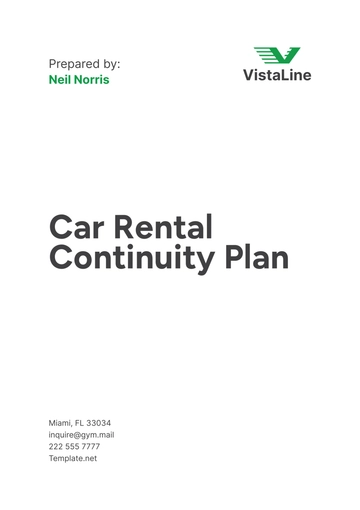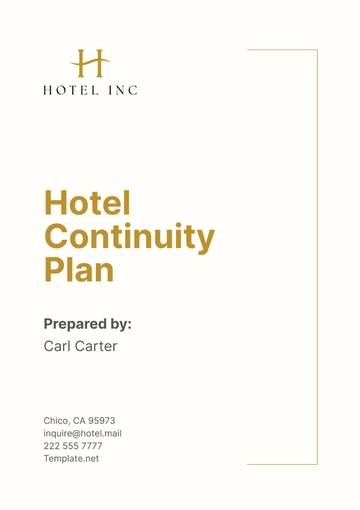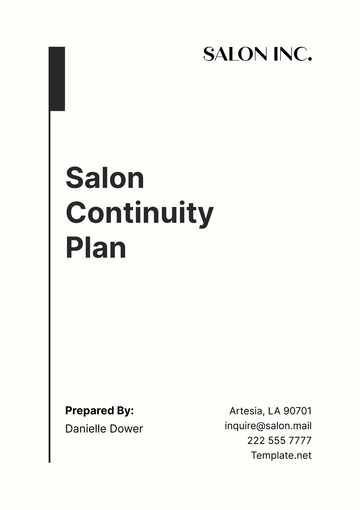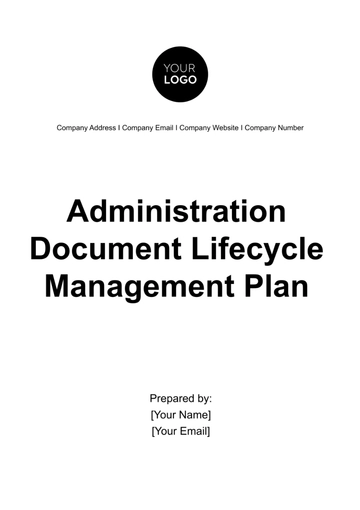Free Travel Agency Continuity Plan
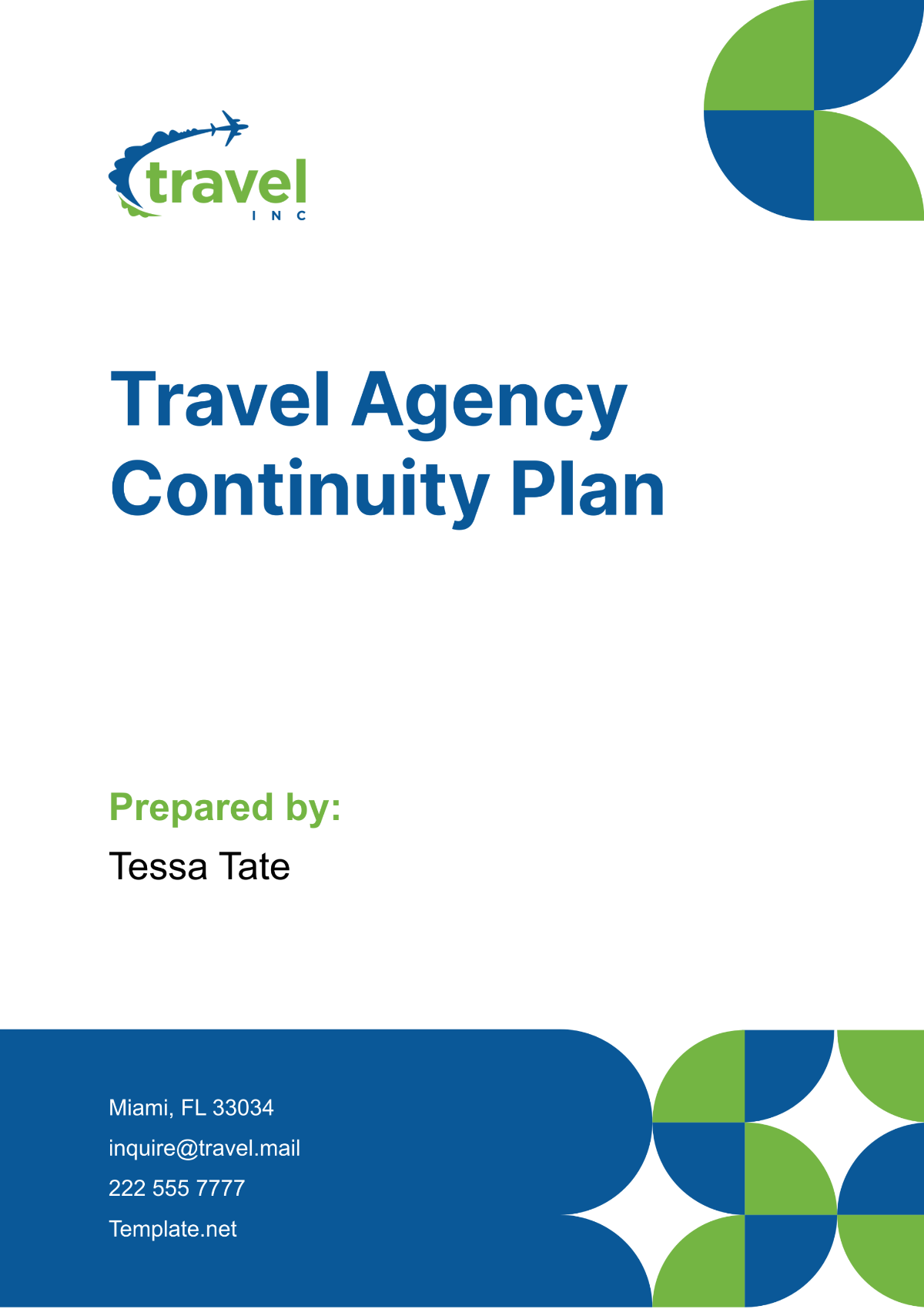
A. Executive Summary
The following continuity plan is crafted to fortify the resilience of [Your Company Name] in confronting diverse potential disruptions. It encompasses strategies to mitigate risks associated with natural disasters, economic shifts, technological breakdowns, and health pandemics. Our foremost objective is to curtail downtime while upholding superior service standards for our esteemed clients, thus safeguarding both our brand reputation and financial robustness.
In realizing this objective, [Your Company Name] commits to proactive measures and rigorous planning to ensure seamless operations during times of adversity. By prioritizing client satisfaction and operational continuity, we bolster our position as a reliable travel partner and reinforce our commitment to excellence in service delivery.
B. Objective Setting
In aligning with industry best practices and regulatory standards, our continuity plan establishes clear objectives aimed at fortifying the resilience of [Your Company Name]. These objectives are devised to address immediate operational hurdles, prioritize the safety and well-being of our dedicated workforce, safeguard critical data assets, sustain seamless communication with stakeholders, and mitigate potential financial losses. By steadfastly pursuing these goals, we reaffirm our commitment to maintaining our position as a leading service provider within the dynamic and challenging landscape of the travel industry.
Main Objectives:
Address immediate operational challenges.
Ensure the safety and well-being of employees.
Secure critical data.
Maintain communication with stakeholders.
Minimize financial losses.
C. Risk Assessment and Management
At [Your Company Name], we recognize that identifying and mitigating risks is paramount to ensuring the continuity of our operations. Through a comprehensive risk assessment process, we have identified several potential threats that could impede our ability to deliver exceptional service to our clients. These risks encompass a range of scenarios, including technological failures, supplier disruptions, geopolitical tensions impacting travel, and health-related closures. Each risk category has been meticulously evaluated for both likelihood and impact, allowing us to prioritize our risk management efforts effectively.
Risk Category | Likelihood | Impact | Description | Mitigation Strategies |
|---|---|---|---|---|
Technological Failures | Moderate | High | Disruptions to IT infrastructure, including system outages, cybersecurity breaches, or software failures. |
|
Supplier Disruptions | Low to Moderate | Moderate to High | Supplier disruptions arising from factors such as bankruptcies, delivery delays, or contractual disputes. |
|
Geopolitical Tensions Impacting Travel | Low to Moderate | Moderate to High | Geopolitical events such as political instability, terrorism, or civil unrest in destination countries impacting travel plans. |
|
D. Technology and Infrastructure
At [Your Company Name], we recognize the critical importance of maintaining robust and reliable IT infrastructure to support our operations effectively. To this end, we are committed to implementing comprehensive measures to ensure the resilience and security of our technological systems.
1. Regular Updates and Maintenance
We will prioritize regular updates and maintenance of our IT systems to mitigate the risk of system failures and vulnerabilities. This includes scheduling routine maintenance checks, installing software patches and updates promptly, and conducting regular hardware inspections to identify and address potential issues proactively.
2. Investment in Redundant Systems
Recognizing the importance of continuity in our operations, we will invest in redundant systems to minimize the impact of potential IT failures. This may involve deploying backup servers, establishing failover mechanisms, and implementing redundant network connections to ensure uninterrupted service delivery to our clients.
3. Cybersecurity Measures
Protecting sensitive customer information is paramount to us. Therefore, we will implement robust cybersecurity measures to safeguard against data breaches and unauthorized access. This includes deploying firewalls, encryption protocols, and intrusion detection systems to detect and mitigate potential threats to our IT infrastructure.
4. Expansion of Cloud Technologies
We recognize the value of cloud technologies in enhancing accessibility and data integrity. As such, we will expand our use of cloud-based solutions to ensure that critical data and applications are readily accessible from anywhere, while also enhancing data redundancy and disaster recovery capabilities.
E. Human Resources Plan
At [Your Company Name], we recognize that our staff are our most valuable asset. As such, we are committed to implementing a comprehensive Human Resources Plan that prioritizes the well-being, safety, and professional development of our employees. This plan encompasses strategies for remote work capabilities, health and safety protocols, continuous training programs, and employee assistance programs. Additionally, flexible work arrangements will be made to accommodate personal or community health requirements.
Aspect | Description |
|---|---|
Remote Work Capabilities |
|
Health and Safety Protocols |
|
Continuous Training Programs |
|
Employee Assistance Programs |
|
Flexible Work Arrangements |
|
F. Communication Strategy
Timely and clear communication is essential for managing a crisis. Our plan includes:
Regular updates to employees via internal communication channels.
Continuous engagement with customers through social media, email updates, and our website.
Emergency contact protocols.
Coordination with local authorities and travel partners.
Transparent communication with stakeholders about the status of operations.
G. Supply Chain Coordination
At [Your Company Name], we recognize the critical role of supply chain coordination in ensuring the seamless delivery of travel services to our clients. To mitigate the impact of potential disruptions and maintain high service standards, we have developed a comprehensive strategy for coordinating with our suppliers and partners.
1. Relationship Management with Suppliers
We will maintain strong and collaborative relationships with our network of suppliers and partners to facilitate effective communication and coordination.
Regular Communication: Establishing regular communication channels to stay informed about potential challenges or disruptions.
Transparency and Trust: Fostering transparency and trust in our relationships to facilitate open dialogue and problem-solving.
2. Development of Contingency Plans
In collaboration with our suppliers and partners, we will develop contingency plans to address critical service disruptions and minimize the impact on our operations.
Identification of Critical Services: Identifying key services and resources that are essential for our operations.
Contingency Planning: Developing proactive strategies and alternative arrangements to mitigate risks and maintain service continuity.
3. Periodic Review of Contingency Plans
We will conduct periodic reviews of our supplier and partner contingency plans to ensure their effectiveness and relevance in addressing evolving risks and challenges.
Evaluation Criteria: Establishing criteria for evaluating the adequacy and effectiveness of contingency plans.
Continuous Improvement: Implementing a process for continuous improvement based on lessons learned and feedback from past experiences.
H. Financial Management
At [Your Travel Agency Name], we understand the importance of financial resilience in navigating disruptions and maintaining stability in our operations. Our Financial Management plan encompasses strategies to build and maintain financial strength, manage cash flows effectively, and mitigate financial risks.
1. Creation of Reserve Fund
We will establish a reserve fund to provide a financial buffer during times of uncertainty or unforeseen disruptions.
Fund Allocation: Determining the appropriate allocation of funds to the reserve fund based on projected expenses and potential risks.
Fund Management: Implementing sound investment strategies to preserve capital and ensure liquidity when needed.
2. Careful Cash Flow Management
Managing cash flows carefully is essential for sustaining operations and meeting financial obligations.
Cash Flow Analysis: Conducting regular analysis of cash flows to anticipate potential fluctuations and identify areas for improvement.
Budgeting and Forecasting: Developing robust budgeting and forecasting processes to plan and allocate resources effectively.
3. Procurement of Adequate Insurance Coverage
We will procure comprehensive insurance coverage to protect against a range of potential risks and liabilities.
Risk Assessment: Assessing our insurance needs based on the nature of our business, industry risks, and regulatory requirements.
Policy Review: Regularly reviewing insurance policies to ensure they remain adequate and up-to-date with changing business needs and regulatory standards.
4. Financial Stress Testing Scenarios
Conducting regular financial stress testing scenarios is essential to assess our financial resilience and readiness to withstand unexpected situations.
Scenario Analysis: Developing and analyzing various scenarios to simulate potential disruptions and their impact on our finances.
Contingency Planning: Using the insights gained from stress testing to develop contingency plans and strategies to mitigate financial risks.
I. Legal and Compliance
In the ever-evolving landscape of the travel industry, compliance with legal standards and regulations is paramount to [Your Company Name]'s operations post-disruption. This section outlines our commitment to understanding and adhering to international travel laws, local health advisories, and industry-specific regulations. Through regular legal audits and consultations, we ensure that our policies remain compliant, relevant, and in line with regulatory requirements.
Legal and Compliance Measures:
Understanding of international travel laws.
Adherence to local health advisories.
Compliance with industry-specific regulations.
Regular legal audits.
Consultations with legal experts to ensure policy compliance.
J. Training and Education
Preparation and training are key components of this plan. Our training program includes:
Regular crisis management and business continuity workshops for employees.
Training in health and safety standards, especially relevant to disease outbreaks.
Customer service training under various potential stress scenarios.
Technical training in tools and technologies that enable remote work.
Leadership training for senior management to handle crisis situations effectively.
K. Testing and Revisions
To ensure the effectiveness of the continuity plan, regular testing will be conducted. This includes simulated disruption scenarios and recovery drills. The plan will be reviewed and revised annually or following any significant incident to incorporate new risks and lessons learned.
L. Implementation Strategy
The implementation of this comprehensive continuity plan will be executed in a structured manner, organized into phases to prioritize critical aspects and ensure the smooth transition of operations. Senior management will lead the implementation process, working collaboratively with department heads to minimize disruptions and maintain operational continuity.
1. Phased Approach
The implementation will be divided into distinct phases, with each phase focusing on specific aspects of the continuity plan. This phased approach allows us to allocate resources efficiently and address the most critical components first.
2. Priority Areas
We will begin implementation by addressing the most critical aspects of the plan, such as IT infrastructure and employee safety protocols. These priority areas are essential for ensuring the resilience and stability of our operations during times of disruption.
3. Leadership Oversight
Senior management will oversee the implementation process, providing guidance and direction to department heads responsible for executing the plan. This leadership oversight ensures alignment with organizational objectives and facilitates effective coordination across departments.
4. Collaboration and Communication
Close collaboration and communication between senior management and department heads are key to the successful implementation of the plan. Regular meetings, progress updates, and feedback sessions will be conducted to ensure transparency and alignment throughout the implementation process.
In conclusion, the Travel Agency Continuity Plan outlines our commitment to resilience and adaptability in the face of disruptions. By prioritizing safety, maintaining robust infrastructure, and adhering to legal and compliance standards, we aim to safeguard our operations and uphold our reputation as a trusted travel partner. With proactive planning and diligent execution, we remain prepared to navigate challenges and continue serving our clients with excellence.
- 100% Customizable, free editor
- Access 1 Million+ Templates, photo’s & graphics
- Download or share as a template
- Click and replace photos, graphics, text, backgrounds
- Resize, crop, AI write & more
- Access advanced editor
Ensure operational resilience with Template.net's Travel Agency Continuity Plan Template. This customizable and editable document simplifies the creation of continuity plans for your agency's operations. Tailored for the travel industry, it ensures preparedness and resilience in the face of disruptions. Editable in our Ai Editor Tool, it enables seamless customization to safeguard your agency's continuity.
You may also like
- Finance Plan
- Construction Plan
- Sales Plan
- Development Plan
- Career Plan
- Budget Plan
- HR Plan
- Education Plan
- Transition Plan
- Work Plan
- Training Plan
- Communication Plan
- Operation Plan
- Health And Safety Plan
- Strategy Plan
- Professional Development Plan
- Advertising Plan
- Risk Management Plan
- Restaurant Plan
- School Plan
- Nursing Home Patient Care Plan
- Nursing Care Plan
- Plan Event
- Startup Plan
- Social Media Plan
- Staffing Plan
- Annual Plan
- Content Plan
- Payment Plan
- Implementation Plan
- Hotel Plan
- Workout Plan
- Accounting Plan
- Campaign Plan
- Essay Plan
- 30 60 90 Day Plan
- Research Plan
- Recruitment Plan
- 90 Day Plan
- Quarterly Plan
- Emergency Plan
- 5 Year Plan
- Gym Plan
- Personal Plan
- IT and Software Plan
- Treatment Plan
- Real Estate Plan
- Law Firm Plan
- Healthcare Plan
- Improvement Plan
- Media Plan
- 5 Year Business Plan
- Learning Plan
- Marketing Campaign Plan
- Travel Agency Plan
- Cleaning Services Plan
- Interior Design Plan
- Performance Plan
- PR Plan
- Birth Plan
- Life Plan
- SEO Plan
- Disaster Recovery Plan
- Continuity Plan
- Launch Plan
- Legal Plan
- Behavior Plan
- Performance Improvement Plan
- Salon Plan
- Security Plan
- Security Management Plan
- Employee Development Plan
- Quality Plan
- Service Improvement Plan
- Growth Plan
- Incident Response Plan
- Basketball Plan
- Emergency Action Plan
- Product Launch Plan
- Spa Plan
- Employee Training Plan
- Data Analysis Plan
- Employee Action Plan
- Territory Plan
- Audit Plan
- Classroom Plan
- Activity Plan
- Parenting Plan
- Care Plan
- Project Execution Plan
- Exercise Plan
- Internship Plan
- Software Development Plan
- Continuous Improvement Plan
- Leave Plan
- 90 Day Sales Plan
- Advertising Agency Plan
- Employee Transition Plan
- Smart Action Plan
- Workplace Safety Plan
- Behavior Change Plan
- Contingency Plan
- Continuity of Operations Plan
- Health Plan
- Quality Control Plan
- Self Plan
- Sports Development Plan
- Change Management Plan
- Ecommerce Plan
- Personal Financial Plan
- Process Improvement Plan
- 30-60-90 Day Sales Plan
- Crisis Management Plan
- Engagement Plan
- Execution Plan
- Pandemic Plan
- Quality Assurance Plan
- Service Continuity Plan
- Agile Project Plan
- Fundraising Plan
- Job Transition Plan
- Asset Maintenance Plan
- Maintenance Plan
- Software Test Plan
- Staff Training and Development Plan
- 3 Year Plan
- Brand Activation Plan
- Release Plan
- Resource Plan
- Risk Mitigation Plan
- Teacher Plan
- 30 60 90 Day Plan for New Manager
- Food Safety Plan
- Food Truck Plan
- Hiring Plan
- Quality Management Plan
- Wellness Plan
- Behavior Intervention Plan
- Bonus Plan
- Investment Plan
- Maternity Leave Plan
- Pandemic Response Plan
- Succession Planning
- Coaching Plan
- Configuration Management Plan
- Remote Work Plan
- Self Care Plan
- Teaching Plan
- 100-Day Plan
- HACCP Plan
- Student Plan
- Sustainability Plan
- 30 60 90 Day Plan for Interview
- Access Plan
- Site Specific Safety Plan
